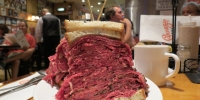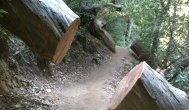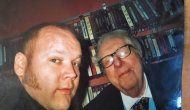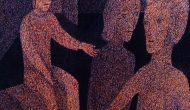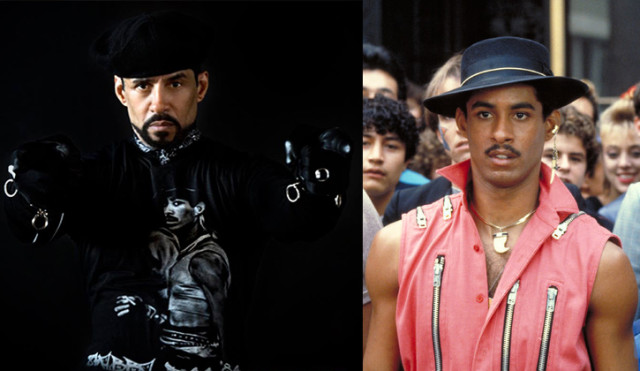 Within minutes of walking into Shabba-Doo’s dance class for the first time, I could tell that his sessions weren’t a “vanity project”; i.e. staging generic dance classes to make money just because he has a big name in the industry. He actually does care that his students learn something by the end of the hour. Even though his students missed dance moves, or couldn’t lock down the routine, he didn’t just dismiss them as novices or non-talents. Instead he encouraged them and explained not to be concerned with missing steps. Dance is art, art is expression of self, be more concerned with the heart, passion, and the source of your motivation rather than perfecting a move you were taught. Because you may not be able to walk out of class with those moves memorized and perfected, but you can walk away with a different view or attitude on your abilities, feeling freer to express yourself, and all of that can filter into other aspects of your life.
Within minutes of walking into Shabba-Doo’s dance class for the first time, I could tell that his sessions weren’t a “vanity project”; i.e. staging generic dance classes to make money just because he has a big name in the industry. He actually does care that his students learn something by the end of the hour. Even though his students missed dance moves, or couldn’t lock down the routine, he didn’t just dismiss them as novices or non-talents. Instead he encouraged them and explained not to be concerned with missing steps. Dance is art, art is expression of self, be more concerned with the heart, passion, and the source of your motivation rather than perfecting a move you were taught. Because you may not be able to walk out of class with those moves memorized and perfected, but you can walk away with a different view or attitude on your abilities, feeling freer to express yourself, and all of that can filter into other aspects of your life.
I stayed through all three of his classes that day, and each one had a philosophical element to them. He gave several metaphors about talent and performing that I could tell came from a place of personal experience (he can easily spot the students that are there because they think it’s cool, and will kindly call them on it, and the ones that are there because they “feel something inside” and need to express it, and encourage them to push that expression further), but the main metaphor that resonated with me was about the “lions”.
He explained there are three types of lions; the “zoo lion”, the “circus lion”, and the “field lion”. Each lion needs to eat, but how they get their food is what makes the difference in their being. The “zoo lion” gets his food because he can’t get his own and must depend on others. The “circus lion” gets his food only when he does tricks for it. The “field lion” gets his food when he wants it, not when someone else hands it to him, or as a reward for performing tricks.
Basically, perform for yourself, because that is what should satisfy you. That is what should fill your “inner-lion’s” belly. If others like you, that is great, but the sounds of an audience’s applause fades. So, if you can perform for yourself, enjoy yourself while you do it, and not do tricks for anyone else’s approval or claps, you will always be a free and full lion, and won’t need others to “feed” you. Who doesn’t want to be a free and full lion?
Shabba-Doo would know a thing or two about being a lion. He is a beast in his own profession. Just to name a few things he’s done in his 40+ years career as a choreographer and dancer: Original Soul Train Gang dancer, member of The Lockers, star of the Breakin’ movies, Hip Hop Hall of Fame inductee, has choreographed for the Academy Awards and Michael Jackson, performed on Broadway, and toured with Madonna and Sinatra, not to mention being a cultural icon of hip-hop and the 80’s. Quite the impressive resume!
By the time class was over, we were sweaty and starving. So I suggested we go for a bite to eat and feed our “inner-lions” while talking about his career and what he’s up to now. We hopped in his car and started talking immediately. I was slightly intimidated by the situation. Here I was sitting next to one of my personal childhood superheroes on our way to grab a bite to eat, but one of the first things he said to me, which I was surprised to hear, was that he was a natural introvert. Being a natural introvert myself with a job/hobby that also forces me out of my shell, I could relate, which immediately put me at ease. He opened up and shared about his background and childhood in Chicago. How he’d just dance for himself alone in his room because it made him happy. His younger sister was the extrovert of the family who also danced, but needed someone to go along with her to dance contests or shows, and he ended up competing too simply because he was there. So, his dance career was just something he was kind of pulled into, but his “inner-lion” surfaced and he learned how to feed himself while entertaining others.
Below is the conversation we had about his life and extraordinary career over Thai food and a mean side of green tea ice cream:
CHOPS: How did you get your start in dance? Who or what influenced you to do it?
SHABBA-DOO: As we talked about, my sister was my motivator. We both went on Soul Train together in ’71, maybe Spring of ’72. We entered a contest at Fullerton College with the BSU (Black Student Union). We went there, and my sister took 2nd place. The guy that took 1st ended up becoming one of The Lockers, Campbellock, Jr. Then we were invited to Soul Train, and we became one of the “Soul Train Gang” with him. When it came time to form The Lockers, they wanted my sister at one point. I wasn’t called on to be in the group until last. I was the last member, and the youngest member.
CHOPS: And the original Lockers were:
SHABBA-DOO: Don Campbellock, Campbellock Jr., Fluky Luke, Willie Williamson, then you had Fred Barry who was “Rerun” aka Penguin. We called him Mr. Penguin, or The Penguin, and Toni Basil (singer of “Mickey”).
CHOPS: That’s crazy she was part of that. I never would have guessed her for an original pop and locker by any means.
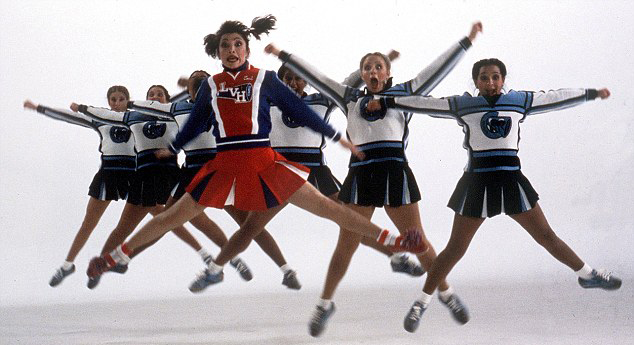 Toni Basil in the “Mickey” video
Toni Basil in the “Mickey” video
SHABBA-DOO: She wasn’t just a part of it. She put it together. Toni Basil was our “Abe Saperstein”, if you know who that is. Abe Saperstein was the founder, creator and owner of the Harlem Globetrotters. He actually formed them from Chicago. They were never in Harlem. He named them the Harlem Globetrotters as a marketing ploy. People knew more about Harlem and it had a better ring to it. Abe had a vision for it, and Don Campbell gets a lot of credit for doing it, but he didn’t do it. Toni did it, the formation of us and managed us in the beginning. And then when she left, I took over the duties.
CHOPS: So you became manager for The Lockers.
SHABBA-DOO: Yeah, I became the unsung hero, the unsung leader.
CHOPS: Where did your street name come from?
SHABBA-DOO: My first street name was “Sir Lancellock”. My name “Shabba-Doo” came from one night dancing at a club called Summit on the Hill near the Baldwin Hills area (of Los Angeles). There was an R&B group performing that night because we danced to bands mostly in those days. Back then, records was something you played between (live) sets to give the band rest. DJs back then were more ‘record player attendants’ and didn’t really have anything to do with the music artistically.
Anyway, the R&B group’s name was Bloodstone, and they would riff like “shabbadabbadoo-bop”, and it was Campbellock Jr. who named me “Sir Lancellock” to begin with, who was like a big brother to me. I said to him “I want to change my name”. He said “to what”? I said “Shabbadabbadoo-bop”. He said “nah man that’s too long. What about SHABBDOO?” Somehow over the years it took on the sound of “Shabba-Doo”. So I just started saying my name was Shabba-Doo. I didn’t even know how to spell it! You might find early items I’ve signed my name to, and might find a different spelling for each one. Then eventually I got to spelling it “Shabba-Doo” with a hyphen.
CHOPS: So is that your professional name only, or do friends call you Shabba-Doo?
SHABBA-DOO: My friends either call me “Shabb”, or call me “The Shabb”. Some people who have tried to be close to me have called me “Shabba”, but my family doesn’t call me “Shabba-Doo”. But my legal name is Adolfo.
CHOPS: Besides “poppin” and “breakin’”, what other forms of dance do you do?
SHABBA-DOO: I can do b-boy breakin’. The umbrella term for all this is “street dancing”. But the media makes it all seem like it’s the same thing. Poppin, Lockin’, are separate dances within themselves. Locking came first. In those days locking and popping was dances you did within the same moment. Not as something separate. You could lock a little and pop, immediately within the same moment. Now they treat them as two separate things and you don’t see a lot of mixing it in the same moment. You might see it in a routine, but I’m talking about somebody that just dances on their own, they wont just start popping and locking all at the same time. Not like we did. So I think at that moment of where that natural mixture occurred organically, gave rise to this interpretation today of the name that lead to “pop locking” as a term. It was “pop lock” because we did it in the same moment. Not popping AND locking.
I also do “Shway-style” which is wacking, or wacking/punking/posing is what it was called in the mid 1970s. I soul dance. I like to think of myself more as a soul dancer. Also salsa, Lambada. Shway style is like an MMA of dance. It’s a mixture and fusion.
CHOPS: So obviously there are new styles of dance that have popped up since you started. How do you feel about something like “krumping” that has clearly taken a page from your style.
SHABBA-DOO: I love it! They’re great. My partner and I, back in the early to mid 2000s produced a show called “Breakin’ vs Krumpin'” And Tight Eyez was the founding father of the Krump Kings.
CHOPS: Was he the one featured in the movie RIZE (2005; directed by David LaChapelle)?
SHABBA-DOO: Later. It came after. When they were in RIZE, they had no name. They were just individuals. He brought them together under the Krump King banner. Gave them focus. Like Toni Basil, he was their Abe Saperstein. See a lot of these guys, including myself when I was younger, didn’t have connections or focus.
Early on, in the early 80s, I was heavily identified with being more a popper, as much as a locker. I was kind of a triple threat. I could wack, pop, and lock equally as well. I let poppin’ go as a performing art. I really enjoy it, but it wasn’t something that gave me great thrill doing by itself. I use it as more of an additive. You even noticed today (in class), that I did it, and I can do it, but I don’t like it in its pure state, its purest form. I enjoy it when it’s mixed, for me. Kinda like having a brandy floater. The drink is already good, but it gives it a little something. Poppin’ is like that for me. An additive.
CHOPS: Your dance troupe was based in LA. At that time, what were popular venues for breaking and battles. Did you guys have a specific venue that you all went to?
SHABBA-DOO: We’d go to clubs like Sideways Camel, Caroline Lanes, Carlos & Charlie’s on Sunset Blvd that became Dublin’s.
CHOPS: Dublin’s Irish Whiskey bar? Wow, I’ve been there 2 dozen times since I’ve lived in LA and had no idea I was hanging out in old breakin’ battle stomping grounds. (laughs)
SHABBA-DOO: There was also the Rhythm Lounge, and a club called Radio. See The Radiotron in the movie Breakin’ was called The Radio (in real life).
CHOPS: So the club in the movie was based on The Radio?
SHABBA-DOO: We were going to use the term The Radio as the name for the club, but they had some legal issues. But we made the club famous for the name Radiotron, basically, but it was going to be called The Radio as it was written in the original script.
I also went to a number of gay clubs too. One was Geno’s on Santa Monica and Vine (in Hollywood). Circus, which is still there. Peanuts was another one. These were mixed heterosexual, bisexual club environments. Ice House, places like that, on Highland (in Hollywood). These kinds of clubs would have homosexuals there and heterosexuals there at the same time. It was kind of a cool time because the gay community and the dance community danced well, very well, they just had a different trip. They (the gay dancers) are the ones that actually came up with the punking and posing. That later became a signature dance style of my own because I started hanging there. A lot of people wouldn’t go there.
CHOPS: Wow that shocks me to hear that the breakin’ community would be progressive enough to go to gay clubs, especially back then.
SHABBA-DOO: Not everybody would go there. Some would and I was one of them. We grew up in the 70s so there was a lot of misconceptions and prejudices about gender, race, sexual preferences, what have you, same shit that goes on today. So there was a lot of these old tales like “you can catch the gay”. Or like, if a gay person touches you, then your arm will fall off. It was these bigger than life kind of lies that you think “how does that work?”. You knew that it wasn’t true or real, but guys didn’t want to test it either. So when I started making my foray into these kinds of nightclubs and environments, it wasn’t popular. I got called all kind of names, or “he’s homosexual”, “he’s sucking dick” “he’s a faggot”. I didn’t stress about it because I knew I wasn’t gay. I feel like I could wear a pink suit if I want to, but I’m not gay. If I like pink, that’s what I like. I don’t care. I’m eccentric, maybe flamboyant, but not gay. If I was in the 50s, I’d be Jerry Lee Lewis, or I would be like Little Richard, or any of those wild, eccentric musical performers. Elvis was eccentric. He’s a blonde dying his hair black. He was eccentric by every sense of the word. Flamboyant even. Look at him even before the 70s. In the 50s he was flamboyant. Wearing gold lame` suits. And he was a white guy! Folks thought “that white boy had lost his mind”, but the girls, they didn’t care what suit he was wearing. But the guys are quick to say something (negative). But a lot of folks wouldn’t wear that stuff, unless you were like Jerry Lee Lewis. He was of that type (flamboyant), but there wasn’t a lot of them.
Anyway, so I’m “eccentric” and all that and dyed my hair yellow or whatever because I like shit like that. I didn’t care about being like everybody else. I did my own thing. Used to love Adam and the Ants. I’d wear war paint and stuff like that. I was into it man! The boxer boots with the fringes, the military jackets, the Indian breastplates and stuff. I was into that. INTO THAT! Moccasin boots and the whole nine. So when I went to those clubs, y’know, I had to suffer because of it. But they danced really well. Learned some great stuff. Learned the punking and posing from them and then what I did was, I brought that into the heterosexual community because those guys would not go into a gay club. There was a stigma to people who went to gay clubs. I took a chance.
CHOPS: And you still have both of your arms today. (laughs)
SHABBA-DOO: No arms fell off. I’m still heterosexual. (laughs)
CHOPS: So you were able to overcome that, able to do your thing.
SHABBA-DOO: So what I created from that is called “wacking”. And now I’ve created my newest creation or convocation of the dance in “Shway style”. Which is more robust. You saw me doing some of that in class today.
CHOPS: Is “Shway” your word?
SHABBA-DOO: Yes, I created the word. So, “Shway” is a shortened version of “Shabba-Doo’s way”, or “the way of Shabba-Doo”.
CHOPS: Dude, that needs to be hashtagged. (laughs)
SHABBA-DOO: (laughs) Back in the day, I had popularized it in such a way, that people were calling it “The Shabba-Doo”. I had TV shows where I did this number with Flip Wilson on an NBC special called Big Show. I was a series regular, and that was right before the death of the variety show market as we knew it. This is about 1979 or 1980 season of NBC. So you’ve got Flip Wilson singing as Geraldine, dressed in drag, singing “get up and do the Shabba-Doo”. I had popularized it to such a degree that people in the clubs were saying “He’s dancing like Shabba-Doo”.
CHOPS: That’s got to make you feel good.
SHABBA-DOO: What’s happened is, one of my biggest sense of pride, or accomplishments is, when I was growing up, when someone would be a fancy dancer, people would say “Oh, he thinks he’s Fred Astaire.”, “Who do you think you are, Fred Astaire?” Now people say “He thinks he’s Shabba-Doo”.
On Family Guy they say that. Chris Rock said it in Grown-Ups, when he and his wife are on the dance floor. The Simpsons has referenced it. Damon Wayans even referenced it in In Living Color. A number of shows are referencing it. And the reason I say this is because, these writers, Seth Macfarlane and all them were fans of Breakin’ because they are of that generation. And they make those jokes because they know demographically people like you are the ones that are going to get it. They don’t write jokes that no one is going to get.
CHOPS: That must be cool to have put your thumb print, not just on your personal career, what you do as a chosen career, but on a specific point in time in pop culture that still resonates today.
SHABBA-DOO: It was hip-hops renaissance. The 80s was hip-hops renaissance period. They tried to make a 2nd coming of it in the 90s, but it never rolled to the level that it did in the 80s. The 90s got too into the packaged idea of an idea. It seemed like in the 80s, it was a little more free willing. Anyone from Grandmaster Flash on, he was in those furry boots and whatnot. Even me, with my fox tails and zoot suit hats and everything, and then moved into the 90s when we got into the baseball cap, and they tried to uniform it, and people lost a lot of their individuality that was so much a part of the 80s. Individuality. I don’t mean in just hip-hop though. I mean all across the board. You had Blondie, (Malcolm) McLaren. You had Herbie Hancock who was a jazz musician. The eclectic feel of the 80s was amazing. All mixing together like it was all one big artistic cluster fuck. That’s when you had Queen on the same bill as (Afrikan) Bambaataa. It was a time when people wore business suits and then suddenly do the “kick worm”. People were crazy! It was beautiful! Hip-hop records represented sort of, a freedom, that later became commercialized and packaged. It lost its shine a little.
CHOPS: Speaking of the 80s, the first time I recall seeing you, your style, was in Xanadu.
SHABBA-DOO: No. Everybody thinks I’m in Xanadu, but I’m not. No matter how many times I tell people I wasn’t in Xanadu, it still comes up. Everybody says I’m in Xanadu. (laughs)
CHOPS: My apologies if I’m insulting your moves or style mistaking someone else for you.
SHABBA-DOO: What it is, is some young guy, who did a really good Shabba-Doo knock off. A really good impersonation. I could fib and say that it was me, and nobody would doubt me. But I never did Xanadu.
CHOPS: Too bad you never got to see Gene Kelley on roller skates in person. (both laugh) That, to me, is a hilarious contradiction. Such a classic, and classy, dancer and they got him to put on roller skates, then dance and skate around Olivia Newton-John.
SHABBA-DOO: Yeah, but he’s incredible, Gene Kelly. You talk about a freak of nature, though. See, those people like that, all come from the same “Michael gene”, that all of them possess: Fred Astaire, Gene Kelly, Michael Jackson, Jimi Hendrix, Paul McCartney, Madonna, Duke Ellington, Dizzie Galespie, Sammy Davis, Thelonious Monk, Charlie Parker, Aretha Franklin, Mozart. They’re all the same people. They all come from the same gene. They are just exceptional people. They have that light. Just exceptional.
CHOPS: That must be crazy to be around.
SHABBA-DOO: I’ve been lucky enough to have been around some of it. Michael (Jackson), Madonna.
CHOPS: You had a huge career before Breakin’ and then that movie kind of made you visible to a whole new and different demographic.
SHABBA-DOO: I had the Soul Train era, and then The Lockers. So when that ended, I had my solo career as Shabba-Doo. I was working quite a bit as Shabba-Doo. Then Breakin’ came. I was already working with Frank Sinatra, Dean Martin, Flip Wilson, Cab Calloway, Lucille Ball, Dick van Dyke, yeah, really gifted people. But Michael (Jackson) grew up on Soul Train, made multiple appearances on there, so he’d learned the dances we created in the 70s.
CHOPS: Is it true that Boogaloo Shrimp (aka Turbo in Breakin’) taught Michael the “Moonwalk”?
SHABBA-DOO: No, I think Michael learned it from a few different people. Not one specific person. I think it was Jeffrey Daniels, Michael Chambers (Boogaloo Shrimp), a kid named Kooley Jackson, and Pop n Taco.
Pop n Taco was the one he graduated from. Pop n Taco gave him his certificate, his diploma. A lot of guys contributed, but I’d give the over all credit to Pop n Taco, who took him to school. When Pop n Taco got ahold of Michael, his whole game changed. It was like when Phil Jackson took over the Chicago Bulls and it took Michael Jordan’s game to a whole new level.
CHOPS: That is an amazing analogy!
SHABBA-DOO: In the poppin’ world, that is what I know to be true. I know first hand to be true.
CHOPS: So, after Breakin’, you went on to be the lead choreographer for Madonna’s Who’s That Girl tour (1987).
SHABBA-DOO: Yes I did. She was at her peak at that moment. We broke records all around the world.
CHOPS: What is it like to tour the world with a celebrity of that caliber? First of all, you were choreographing for someone of that personality, I understand she’s an extremely hard worker and expects those around her to work as hard as she does.
SHABBA-DOO: She was nice to me. She is a hard worker and all that, but she has a great side to her too. She can be quite funny, and we had, at some point, we had somewhat of a personal relationship. Which is public record now because her brother wrote about it in his autobiography.
CHOPS: Wow, he did?
SHABBA-DOO: Yeah he did. We had a relationship. But I was that kind of “joe” back then. I was a bit of a playboy I’d say.
CHOPS: So have you guys stayed in touch since?
SHABBA-DOO: No. I did the Who’s That Girl tour, and was offered the next tour, but declined. And it kind of damaged our relationship a little bit because Madonna has the attitude that no one can tell her “no”. But back in those days, I believed, and was, just a big a star as her but in my own way, in my own right. So it was like, the same relationship that happened with Bennie Goodman and Frank Sinatra. Sinatra started playing in his band. Eventually he had a rise to fame with Bennie, but Frank had a following. So, I already had a following. Madonna was my fan at that point. I didn’t even have to audition for it. She just offered me the job.
CHOPS: So you guys had not met before professionally or at an event?
SHABBA-DOO: No, she contacted me at my home and offered it to me.
CHOPS: That is a HUGE compliment and testament to your work.
SHABBA-DOO: Oh yeah. Didn’t have to audition. But then when I turned down the tour after, I think it was Blonde Ambition. Yeah, I turned down Blonde Ambition to do Lambada for Warner Bros. I had a 3 picture deal with Canon (Films); Breakin’ 1 & 2, and Lambada. I starred in that film and choreographed it too. So when I got the offer for the film, to lead and choreograph the movie, I turned down Madonna’s world tour, I think it kind of damaged the relationship because she just expected me to do it, and I didn’t. I figured I’d done it (choreographed a big tour), so I’m done, and wanted to pursue my acting career and film career. I did Lambada, but in hindsight, I probably should have done Blonde Ambition (laughs).
CHOPS: Yeah, that was a huge era for her. I believe that was the “Vogue” tour.
SHABBA-DOO: Yeah, yeah, you know with “Vogue”, I taught her first. You see it in the Who’s That Girl tour. That one dance move I showed you (in class) where she’s doing her arms like this (he demonstrates). Yeah, that was the beginning of her vogueing. So, I introduced her to that. That’s why she wanted me to do the next tour. If I had done the second one, I’d have been in the “Vogue” (video), and Truth or Dare (1991; directed by Alek Keshishian). And if you notice, there was a lot of guys in the “Vogue” video that had a similar look to me. Kind of trying to reduplicate the Shabba-Doo. (laughs) Light skinned, slicked back hair, that Duke Ellington kind of look. I played that card first.
CHOPS: That really is huge man. You’re very lucky to have been associated with all of that.
SHABBA-DOO: Yeah, that was an iconic tour. So if you think about it, I’ve been really really fortunate to have done Soul Train, which is an iconic show. To be one of The Lockers, an iconic group which is where street dancing started as the world knows it. We changed dance forever. Six black guys and a white girl changed dance forever.
Actually I have a film I’m working on about the six black guys and white girl called “Kings of Crenshaw”.
But anyway, then I had the Shabba-Doo era. See after The Lockers, there came the Shabba-Doo era with the hair and the suits, the pencil moustache and everything. And then I entered my performance era, which includes Bette Midler Divine Madness on Broadway. Katie Segal was a backup singer. I was in Divine Madness, both the tour and the Broadway show. I was one of the stars of it. It got great reviews, which got me into series with NBC, which lead to all that other stuff.
Then I did the world’s first hip-hop documentary. It wasn’t Wild Style. The one I did with Topper Carew was the first one, called Breakin’ n’ Enterin’. I actually put that together and sold the idea to Topper Carew over at Rainbow Productions. Topper Carew was the Executive Producer (and Co-Creator) of the Martin Lawrence Show. That documentary wasn’t the first West Coast hip-hop documentary, it was the first hip-hop documentary period. Everything else came after that.
Check out the full documentary:
https://www.youtube.com/watch?v=GFkgObeA8AU)
CHOPS: I’ve seen that. It featured a bunch of the cast of Breakin’ dancing or battling on Hollywood Blvd long before the gentrification it is now experiencing. Ice-T is in that as an MC as well.
SHABBA-DOO: Ice-T was an unknown, so I sold the idea. Then they put together the soundtrack idea with Chris “The Glove” Taylor and Ice-T. They handled the music. I didn’t understand full weight of “titles” in those days, so you’ll see “Shabba-Doo as the Choreographer” and the “Talent Coordinator” of Breakin’ n’ Enterin’, they gave me that (the titles) and my own office right here at Sunset Gower Studios. So I wasn’t just a player.
Here’s the thing, I was the mastermind behind the entire street dance West Coast movement. I brought in Boogaloo Shrimp. Everybody that you know, that’s famous right now, they came through my gate. I christened them. That’s not just me saying that. That’s real. You do your research, check it out, they had no presence until after Shabba-Doo. Every single one of them. Pop n Taco, Anna Sanchez, Lollipop, Poppin Pete, Electric Boogaloo, Turbo. Every single one of them, I gave birth to. It started to be like I owned it. I owned the 70s and I owned the 80s. It was unquestioned. I owned two decades of street dancing. And to this day, no one has touched me. No one.
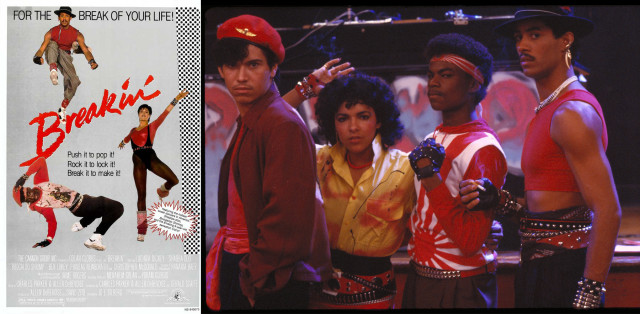 Breakin’ poster; Still shot from Breakin’ – From left to right: Pop n Taco, Anna Sanchez, Boogaloo Shrimp, Shabba-Doo
Breakin’ poster; Still shot from Breakin’ – From left to right: Pop n Taco, Anna Sanchez, Boogaloo Shrimp, Shabba-Doo
CHOPS: Honestly I can’t recall any choreographers names off the top of my head. I mean, there was Tina Landon with Janet Jackson in the early 90s, maybe very late 80s. Kenny Ortega who was with Michael Jackson at the end.
SHABBA-DOO: But look, those people are famous because of who they work with. But they are not famous on their own. I was famous without them (celebrities). That puts me in the Fred Astaire/Gene Kelley realm.
When I was on tour with Madonna, they gave me billing. That’s unheard of! That’s how big I was. All other dancers you’ve ever seen on stage, no one has heard of. Name them. You can’t.
The only one that can kind of come close, but then she needed the music in order to do it, was Paula Abdul. Paula is more “super” than Tina (Landon), because she made it on her own, without them (big name celebrities), but she still had to resonate with the world. She had to create a following. She did that! But even she is not even close to what I did because she doesn’t command a culture like I did. See, I wish I could say I thought of it, but I didn’t. I just recognized it was happening.
I was one of the original Soul Train performers, one of the original Lockers, and the star of the Breakin’ films, all in one. Each one of those would be good for someone on their resume. I have them all. And I wasn’t even supposed to be the guy. I just wanted to dance in my room. I didn’t care about all that other stuff, and I got thrown into it.
CHOPS: So do you keep up with any of the original people like Toni Basil, Ice-T, Boogaloo?
SHABBA-DOO: I don’t speak to Boogaloo Shrimp. I’m not angry at him, we just have nothing in common. I have no negative feelings for him or towards him. I just have no desire to work with him at this point. I think that our time spent together was magical, beautiful. I will always cherish and remember it, but I have no desire to continue. Sort of like Dean Martin and Jerry Lewis. Just time to go. I was his straight man. His Dean Martin. He was Jerry Lewis, really.
CHOPS: So, what about Toni Basil?
SHABBA-DOO: Yeah I speak to Toni. We have a healthy, but infrequent relationship.
CHOPS: Ice-T?
SHABBA-DOO: No I do not.
CHOPS: I hear, through my research, he’s kind of turned his back on that whole era in his career calling it “wack” and whatnot.
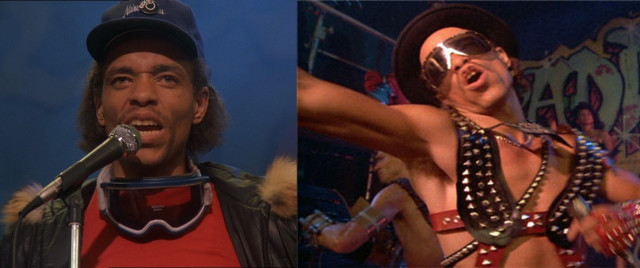 Ice-T in Breakin’ and Breakin’ 2: Electric Boogaloo
Ice-T in Breakin’ and Breakin’ 2: Electric Boogaloo
SHABBA-DOO: Well, he thinks he’s much more serious and better than it was.
CHOPS: Yeah, it’s interesting to see him go from rapping about break battles and tagging territories to releasing “Cop Killah” with Body Count 6 years later. That’s a huge difference in subject matter. I’m not bagging the guy by any means. He’s had a huge career from where he came from.
SHABBA-DOO: Yeah, he’s wonderful and he was great, but I just don’t have any contact with him.
CHOPS: Lucinda Dickey who played Kelly (Special K) in Breakin’?
Lucinda Dickey as “Special K” in Breakin’ 2: Electric Boogaloo
SHABBA-DOO: I don’t speak to Lucinda either. None of them really (from Breakin’).
CHOPS: Not Pop n Taco?
SHABBA-DOO: No I do not.
CHOPS: I know he’s down in Long Beach area.
SHABBA-DOO: Yeah I think he is down that way, but we don’t really speak.
CHOPS: I see Anna Sanchez in the movies, videos from the 80s, and the documentary Breakin’ n’ Enterin’, and seems like she was prominent on the scene back then.
SHABBA-DOO: She was my student. She was in my troupe. My troupe at the time was Anna Sanchez, Boogaloo Shrimp, Pop n Taco, and Lil Coco.
CHOPS: I realize I’m asking about 30 year old relationships.
SHABBA-DOO: I don’t speak to any of the Breakin’ cast members really. I’m very different at this point. It was cool when it was cool. It’s still not uncool, I just have no feeling about them. We’ve done our thing. We’ve shot our wad. It’s done.
CHOPS: As we’ve discussed, you’ve had 4 eras of your career, what is your favorite memory from your entire career.
SHABBA-DOO: My favorite memory? Out of my whole career, even bigger than Michael (Jackson), it was opening for Frank Sinatra. Old Blue Eyes.
CHOPS: Wait, you opened for Frank Sinatra? What did you do?
SHABBA-DOO: We did a dance show for his tour. We opened for him. Performed at Carnegie Hall. So, The Lockers were in Carnegie Hall!
CHOPS: From the streets of LA to opening for Frank Sinatra with street dance. That is brilliant!
SHABBA-DOO: That’s amazing in itself, but when his bodyguard or valet or whoever it was came to get us, and said “Frank wants to see you boys.” They called us “boys” too, even though some of us were men. I was 21 around then myself.
Anyway, so we go into the dressing room, and it was like meeting the Pope or something. I grew up watching the Saturday morning musicals and movies. I knew who Frank was. It’s Frank Sinatra! He’s actually bigger to me than Elvis. He’s like the Pope. Meeting the fucking Pope. Sitting there in this ornate looking chair, had the ascot with the robe, velvet shoes with the crowns on them. It would have been like meeting Darth Vader, even. Not in a dark way, just in the whole presence of him. Just WOW! Frank had risen to this mythological level, otherworldly.
He was smoking a cigarette and he said (affecting a Frank Sinatra voice) “You boys, you boys are good!” And I was like “oh shit!” It was that feeling like when they open the suitcase in Pulp Fiction and the light shines. Like an alien abduction feeling in there. I thought I was going to hear heavenly horns. Because you hear all these myths and legends, you know he’s the boss. And you get that feeling you don’t fuck with him. Even though he smiled at us, we still got a feeling of don’t fuck around. He’s seen a lot of shit. He’s seen everything. What are you going to tell him? You ain’t gonna tell him nothing. It’s Frank Sinatra!
I didn’t know it then, but I watched a documentary not too long ago on Netflix or Showtime, about what he went through. And it explained to me what I saw that day. Because I didn’t know it. I just looked at him, and it was like getting hit over the head with a hammer. It’s Frank Sinatra!
And you go through another phase “Fuck, it’s Frank Sinatra!” It’s one layer of “Fuck, it’s Frank Sinatra” after another. So I remember that day clearly. From what he wore, to the gangster bodyguard looking dudes in there talking about Jimmy Caan (James Caan), and Frank told us how good we were.
CHOPS: Last question: In the bearding world I go by “Chops Johnson”, so if I were to become a dancer and be in your troupe, what street name would you “knight” me with?
SHABBA-DOO: Chopz-Suey! (laughs)
CHOPS: That’s so cool! I’ve wanted a street name since I was a kid, but being a white boy from Louisiana, that never happened. Dude, thank you! I feel “cool” now! (both laugh)
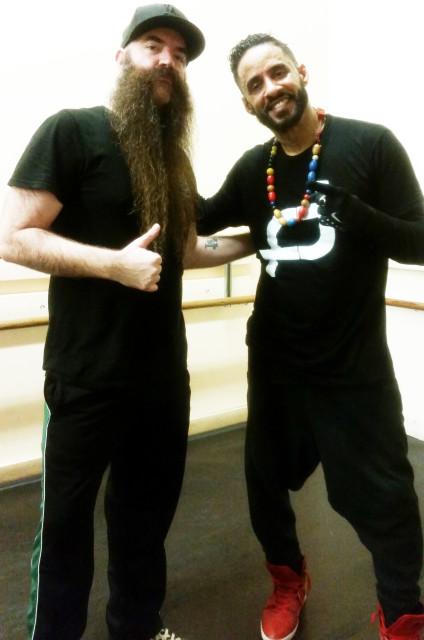 Shabba-Doo and I after Locking class
Shabba-Doo and I after Locking class
Follow Shabba-Doo at:
**To follow Shea Magazine on Facebook go HERE!**
**To follow Shea Magazine on Twitter go HERE**
**If you liked this article you should share it!**
Nate Johnson (Sr. Contributing Editor, Los Angeles)
Nate “Chops" Johnson currently holds more than a dozen competitive bearding titles, including 6, 1st place victories, and 2 for Best In Show. He lives in Los Angeles, and enjoys Pabst Blue Ribbon beer.
- Web |
- More Posts (27)
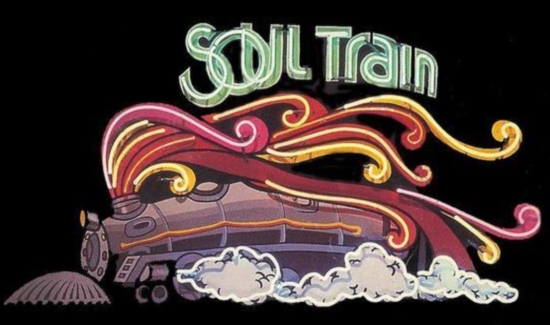

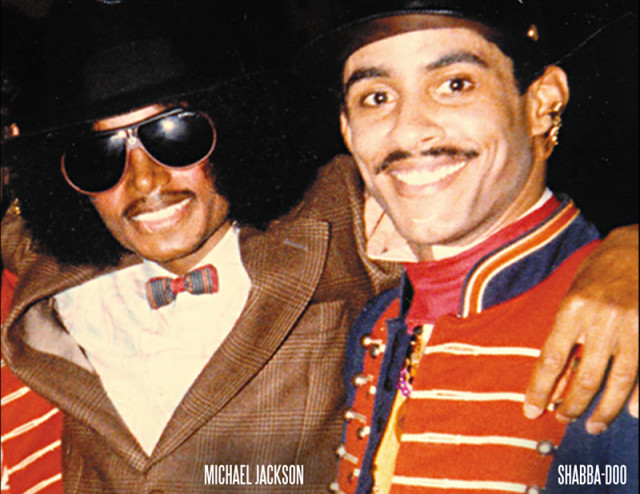
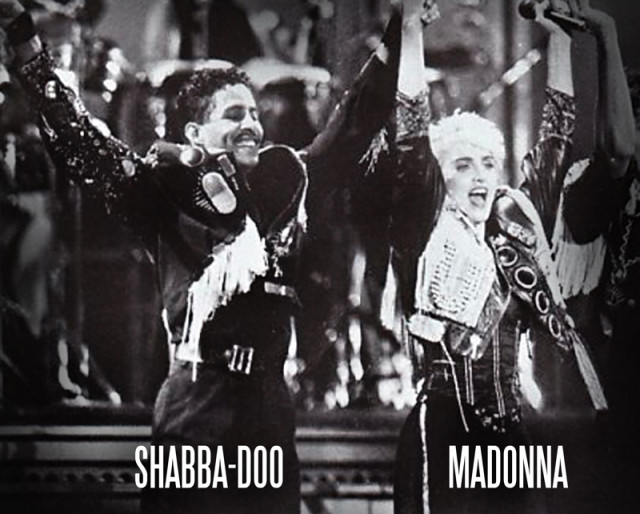
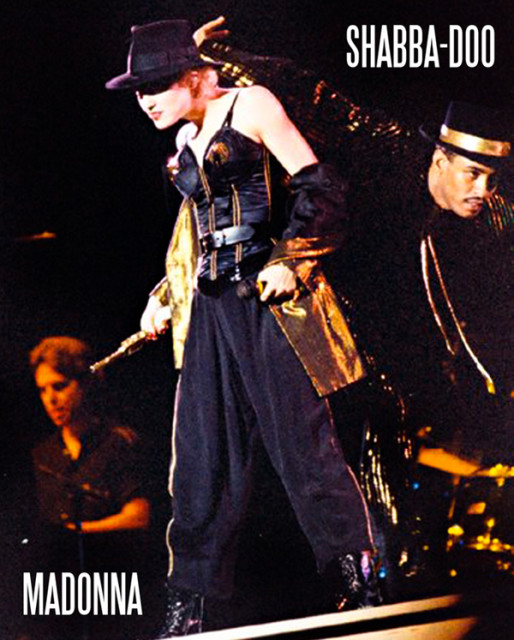
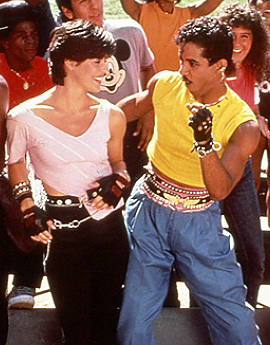




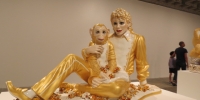

![Let's Go to Chinatown, Shall We? [PHOTOS]](https://sheamagazine.com/wp-content/plugins/special-recent-posts-pro/cache/MjAwMTAwbm9jaGluYXRvd24tMi1idy0=.jpg)
![Sunset - Pelham Shore Park - Long Island Sound [PHOTOS]](https://sheamagazine.com/wp-content/plugins/special-recent-posts-pro/cache/MjAwMTAwbm9JTUdfMzM3MC1SRVNJWkU=.jpg)

![Scenes from Washington Square Park - NYC [PHOTOS]](https://sheamagazine.com/wp-content/plugins/special-recent-posts-pro/cache/MjAwMTAwbm9JTUdfNDA1Mg==.jpg)
![Let's Go to the Empire State Building - Shall We? [PHOTOS]](https://sheamagazine.com/wp-content/plugins/special-recent-posts-pro/cache/MjAwMTAwbm9JTUdfMzkxNjE=.jpg)
